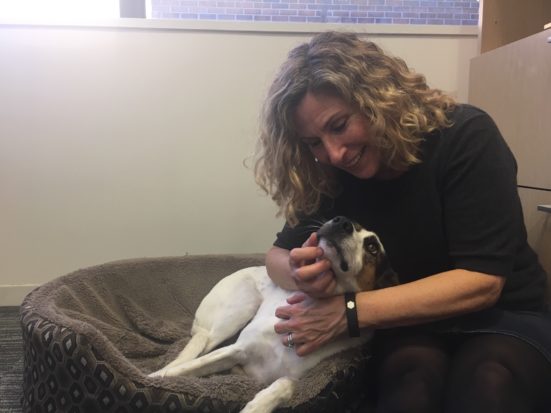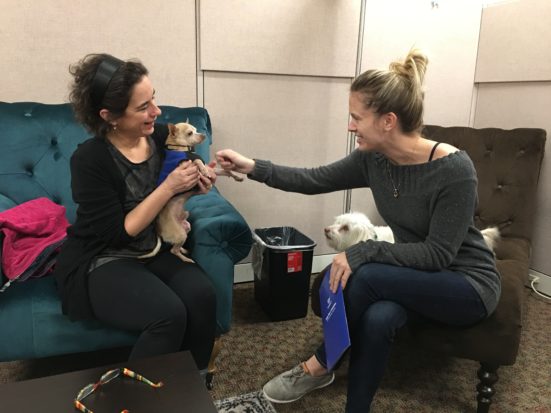
Participants in our Pets in the Workplace program reflect the companion animal issues we work on. My dog Lilly was a street dog rescue from Trinidad and Tobago where HSI worked locally with a shelter partner. Photo by Corine Weiler/The HSUS
One of the great benefits of working at the Humane Society of the United States is that staff members can bring their pets to our offices. For me, that means Lilly, my sidekick, can come to work with me. She loves nothing more than visiting colleagues for treats and pats and socializing with the other dogs in our workplace. And I love having her there with me.
We launched our Pets in the Workplace program seven years ago, and there are now more than 100 participating pets, mostly dogs. It is a popular program, to say the least. The dogs don’t have to sit alone at home, and they get to make lots of new friends. Staff members save on doggie daycare, of course, but the real value for them is that they get to enjoy the companionship of their best friends at work. We expanded the program several years ago to also allows foster dogs to come to the office, which often helps them find a home and allows staff to be able to foster dogs in the community if they don’t have their own dog.
On any given day, you’ll find dogs of all shapes, sizes and breeds walking our office grounds (on leash), sleeping contentedly inside office cubes by their people as they work, or socializing with other pets.

Kathleen Summers (left), director of outreach and research for the puppy mills campaign, with her dog, Satito, and Meredith Blanchard, public policy coordinator for the puppy mills campaign, with her dog, Kola. Photo by Morgan Miller/The HSUS
Dogs in the workplace programs are increasingly becoming popular around the country. Amazon reported in a blog this year that its employees bring 6,000 dogs in to work each day. A USA Today article, quoting the Society of Humane Resource Management, said eight percent of workplaces in the United States now allow dogs to join their owners in the office — up from five percent in 2013. Several years ago, when choosing new offices, allowing dogs there was a critical element of our selection process and an important component of our lease. Our Washington, D.C. landlord has since received an award for its embrace of pets in the workplace.
If there is anything that distinguishes our program from others of its kind, it is the fact that our pet participants reflect the companion animal issues we work on, and the dedication of our staff to ending animal cruelty, both on a wider scale, through their work, and at a personal level, by adopting individual animals.
There’s Satito, at just five pounds, recently adopted by a member of our Puppy Mills Campaign. When our colleague met Satito during the Spayathon in Puerto Rico, he was living on the streets and near starvation. There’s Nugget, a large, mixed Husky who was adopted by the vice president of our Animal Rescue Team after she helped rescue him from a large-scale cruelty case. There’s Charlie the terrier mix, adopted by another ART member after Hurricane Maria, and three-legged Maximus the mastiff, who was adopted by our deputy manager of animal crimes after being found as a stray. There’s Liam, an American Staffordshire terrier who was hit by a car before being rescued and fostered, and later adopted, by a public policy specialist in our companion animals team. There’s Sunny, a golden retriever-Chihuahua mix, found by a program specialist who works on The Shelter Pet Project, a public service campaign sponsored by the HSUS, Maddie’s Fund and the Ad Council. There’s Bella, rescued from a Korean dog meat farm by Humane Society International and adopted by our senior vice president of animal care, rescue and response. There’s Dimitri, a blind sharpei rescued from a puppy mill by HSUS and adopted by a staff member in the Office of the President and CEO. And my own Lilly was a street dog rescue from Trinidad and Tobago where HSI worked locally with a shelter partner.

Each year, we organize an in-house holiday gift exchange for the dogs, and there’s even talk of an ugly sweater contest this year.
Those familiar with the program say that it has been fantastic for the morale of employees because they can take a break for a walk or to play with their dogs during a stressful day. And studies bear this out. Research by the Virginia Commonwealth University showed employees with pets at their workplace showed an 11 percent drop in their stress levels by the end of the workday as compared to a 70 percent spike in stress levels of employees who left their pets at home.
Allowing pets in the workplace has other advantages, besides being good for employee morale. Many people don’t adopt because they think they are too busy or just don’t want to leave their dogs at home alone all day.
Lilly seems already engaged with the holidays this year: we organized an in-house holiday gift exchange for the dogs, and there’s even talk of an ugly sweater contest.
I’m personally encouraged by the success of our program, and about the proliferation of such programs around the country. We’ve helped quite a few businesses implement a pets at work program, and the number of inquiries has increased over the last few years. We’re happy to share resources with you if you are interested in seeing your own workplace go to the dogs. Email us at blog@humanesociety.org for more information.
The post Pets in the workplace: Why we let the HSUS go to the dogs appeared first on A Humane Nation.
Enviroshop is maintained by dedicated NetSys Interactive Inc. owners & employees who generously contribute their time to maintenance & editing, web design, custom programming, & website hosting for Enviroshop.
